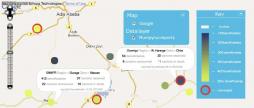We present a low-cost, energy-efficient system to remotely monitor the temperature and location of vaccines in a countrywide “cold-chain”. Our system is based on FoneAstra [11] – a low-cost, microcontroller-based, programmable device that extends capabilities of low-tier mobile phones that are commonly used in developing countries.
In the system discussed in this paper, FoneAstra is enhanced with a digital temperature sensor and integrated with a vaccine cold-box used to store vaccines in a temperature controlled environment. FoneAstra continuously monitors the temperature of the cold-box, aggregating readings over a period of time.
It uses the mobile phone to which it is coupled to send periodic SMS messages with routine temperature reports or immediate alerts if it detects abnormal temperature conditions. Additionally, it enables location-tracking of vaccines in transit, based on the mobile phone’s cell tower-IDs.
We present results from an ongoing lab-deployment done at PATH [18], our Seattle-based partner NGO for this project. Over the next few months, we will deploy this temperature and location monitoring system for vaccine cold-chains in several countries in which PATH operates.
The client in this system, which includes a temperature sensor, FoneAstra and a mobile phone, costs $50; while the server, which includes a Netbook and a GSM modem, costs $500. We discuss how our system can scale up to enable large-scale monitoring while incurring low overhead costs.

